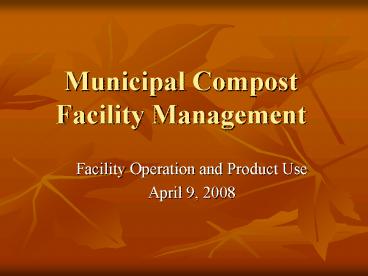Municipal Compost Facility Management - PowerPoint PPT Presentation
1 / 28
Title: Municipal Compost Facility Management
1
Municipal Compost Facility Management
- Facility Operation and Product Use
- April 9, 2008
2
Leaves, grass clippings and yard debris are NOT
waste, but resources that can be used to produce
a valuable product!
3
Composting as a Manufacturing Process
- Producing a Product
- Quality can be measured
- End use will influence process and inputs
- Regulatory Issues/Health and Safety
- Product Use
4
Wisconsin Regulations
- Administrative Rules
- NR 500
- NR 502
- NR 518
- DNR oversight
5
Regulatory Requirements
- Location
- Design
- Operation
- Performance
6
Types of Compost Facilities
- Yardwaste
- lt 20,000 yds3
- gt 20,000 yd s3
- Food Waste - Vegetable
- lt 500 yds3
- gt 500 yd s3
- Onsite Farm Waste
- Solid Waste Processing Facility
7
Yard Waste Composting Facilities w/ capacity of
20,000 yds or less
- Yard Waste materials
- Clean chipped wood waste
- Regulations address
- Location
- Design
- Operations
- Operating license is required, but exempt from
plan approval.
8
Location Requirements
- Compost Facilities may not locate
- W/in a floodplain
- W/in 5 of seasonal high groundwater table
- 250 of a private well or 1,200 of a public well
- 250 of a navigable water
- w/in 1000 of a state hwy or interstate
- w/in 1000 of any public park
- w/in 100 of land owned by a person other than
the owner or operator of the facility
NR 502.12 (8)
9
Design Requirements
- Runoff Control
- Compost pad shall be sloped sufficiently to
prevent ponding - Discharge to a gentle sloping grassed area
- Erosion control on site using vegetation,
containment ditches and retention ditches - Ditches and berms shall be used to prevent storm
water run-on - Facility size shall be based upon process
residence times for materials to be composted
NR 502.12 (11)
10
Obtaining a License
- Submit request for an initial site inspection.
- DNR completes ISI w/in 22 days.
- DNR issues preliminary opinion letter w/in 22
days of ISI. - License issued if all criteria are met.
- Construction operation can begin.
NR 502.04(2) NR 500.05(5) to (8)
11
Operational Requirements
- Good management practices should meet most
operational requirements. - Odor
- Vectors
- Nuisance
- Stockpiling
- Accumulation of material
- Maintain quality
NR 502.12 (10)
12
Operational Requirements
- Materials shall be source separated from
non-approved wastes - Materials shall be debagged w/in 24 hours
- Grass clippings shall be incorporated w/in 72
hours. - Materials shall be size reduced if necessary for
effective composting
NR 502.12 (10)
13
Operations Cont.
- Mixed aerated as necessary to ensure adequate
Oxygen turn when temp gt150 or O2 lt 15 - Minimum CN of 121 - (201 -401 is optimal)
- Windrow size and spacing shall meet the
capability of facility equipment
NR 502.12 (10)
14
Operations Cont.
- Wet materials for dust control efficient
composting (50-60 is recommended) - Materials resulting from composting shall
- Be stabilized to eliminate pathogens
- Not reheat upon standing
- Be free of sharp particles
- Be free of toxins which could cause harm to
public health or the environment
NR 502.12 (10)
15
Operations Cont.
- Compost product storage time shall be minimized
to maintain the quality of the compost and
prevent excess stockpiling - Facility shall be operated in a nuisance free and
environmentally sound manner
NR 502.12 (10)
16
Performance Standards
- Compost or any solid waste facility shall not
- Have a detrimental effect on any surface water
- Have a significant adverse impact on wetlands
- Have a detrimental effect on groundwater quality
- Take an endangered or threatened species
- Cause the migration and concentration of
explosive gases - Cause the emission of any hazardous air
contaminant exceeding limitations in NR 445.04 or
445.05
NR 502.04 (1)
17
Bottom Line to Meet Performance Standards.
- Control Run-off
- Control Odors
18
A Final Thought on Operations
- Size of a facility is related to volume of
material. - Slow Process More Space
- Shorten the cycle time to increase capacity
19
Health and Safety
- Heavy equipment
- Noise
- Flails, screens, hammers
- Feedstocks
- Metal, bowling balls, rocks
- Spontaneous combustion
- Pathogens
- Skin contact
- Aerosols- Molds Fungi
20
Compost Product Use
- Compost is a valuable product
- Municipal Uses
- On-site
- Parks and Facilities
- Erosion Control
- Reduce sediment transport
- Speeds revegetation
21
Not All Compost is the Same
- Feedstock material inputs
- Particle Size
- Tailor for final use
- Photo courtesy US EPA
22
Compost Product Qualities
- Chemical
- pH, soluble salts, NPK, etc.
- Carbon/Nitrogen
- Physical
- Bulk density, particle size, moisture
- Inerts
- Biological
- Stability/Maturity
- Weed seeds
23
How to Use Compost
- Use as a soil amendment
- Improve soil quality
- Speed vegetation establishment
- Stormwater applications
- Control sediment
- Retain water onsite
- Improve infiltration
Photo courtesy US EPA
24
Stromwater Use Resources
- EPA BMPs
- Blankets, Berms and Socks
- Mulching for Construction Sites WiDNR
- Wisconsin DNR Specification S100 for Compost
25
Compost Recipes
- Feedstocks and particle size
- Compost blankets courser materials
- Soil amendments leaves/grass possibly
shredding - Balance Carbon and Nitrogen
- Higher CN if erosion control
- Lower CN if vegetation
26
Sampling and Monitoring
- Use your senses
- Hands for moisture
- Nose for turning
- OR,
- Temperature Probes
- Oxygen or CO2 measurement
- Add water when needed
27
In the Future
- Food waste composting
- Compost and the carbon market
- Building soils
28
- Joe Van Rossum
- UW-Extension Recycling Specialist
- 608-262-0936
- vanrossum_at_epd.engr.wisc.edu































